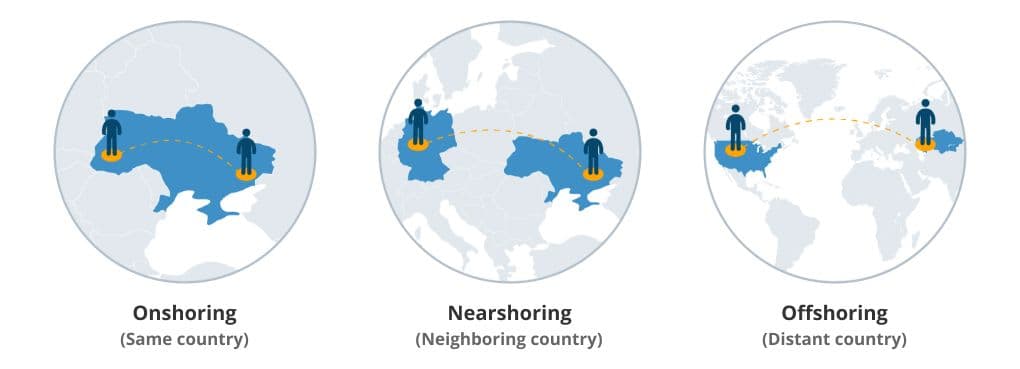Nearshoring: Definition, benefits, examples, and how to know it’s right for your business
Nearshoring, a business practice that has been growing in popularity in recent years, is the process of outsourcing work to a company or individual located near your own.
It has many benefits for both parties involved and can be an excellent way to improve efficiency and communication within a business.
But nearshoring is not right for every company, and there are a few things you should consider before making the decision to outsource near your home base.
What is nearshoring?
Nearshoring is the process of outsourcing work to a company or individual located near your own.
The term nearshore generally refers to outsourced work that is done in a nearby country that share a border with the country where the work is being done.
For example, a software development company in the United States might delegate projects or tasks to a software development team in Mexico. Nearshoring can also include outsourcing work to other countries in close proximity, such as Canada or Europe.
Example of nearshoring
The benefits of nearshoring
There are many reasons why the nearshoring model has become so popular in recent years. Here are just a few:
Improved communication
When you outsource work to someone near your own location, it becomes much easier for team members on both sides to communicate effectively.
There are little or no cultural differences or language barriers, and because they are either in a similar or the same time zone, you can easily arrange face-to-face meetings. This can lead to faster turnaround times.
Cost savings
Nearshoring can help save costs, as companies don’t need to invest in long-distance travel or expensive video conferencing solutions like they would if they were nearshoring overseas.
Greater flexibility
Nearshoring allows your business to be more agile and adaptive to changing market conditions, as it is easier to scale up or down quickly with nearshore partners.
Faster delivery times
Nearshore locations tend to have shorter lead times on projects, meaning that the work gets done more quickly and efficiently, making the product supply chain more efficient.
Types of businesses that use nearshoring
Nearshoring can be a great option for businesses of all sizes, from small startups to large multinational corporations. Here are some examples of companies that nearshore:
Software development
Technology and software companies outsource nearshore programming tasks to increase efficiency and reduce costs. Famous examples include IBM, Microsoft, and Oracle.
Manufacturing
Nearshoring can help reduce manufacturing costs and increase productivity. Companies such as Apple and Samsung have nearshored parts of their production processes to countries like Mexico and China.
Marketing
Nearshore partners can help companies increase the reach of their marketing campaigns quickly and cost-effectively. Companies like Nike and Coca-Cola nearshore marketing tasks to increase their global reach.
Business processes outsourcing
Businesses nearshore back-office functions such as bookkeeping, customer service, and data entry to increase efficiency. Companies like Amazon and eBay nearshore tasks related to these business operations to countries such as India and the Philippines.
Research & development
Companies nearshore R&D tasks to access specialized expertise and benefit from shorter turnaround times. Companies such as Google and Facebook nearshore research & development tasks to countries like Ukraine and Finland.

How to know if nearshoring is right for your business
Nearshoring can be an excellent way for businesses to increase efficiency and reduce costs. However, it is not the right solution for every business. Here are a few factors you should consider before nearshoring:
Your skillset
Nearshoring requires a certain level of expertise on both sides to ensure success. Assess whether your business or the nearshore partner has the necessary skills and expertise to successfully handle the outsourced tasks.
Customer expectations
Nearshoring can help speed up delivery times, but if your customers expect quick turnaround then nearshoring might not be the best option as it may take longer than they’re expecting.
Your nearshoring partner
When nearshoring, it’s important to make sure you choose a reliable and experienced nearshore partner who can handle the work you need done and that you can expect consistent quality.
It’s also wise to evaluate the reliability, experience, and cultural compatibility of potential nearshore partners to ensure a successful collaboration.
Budget
Nearshoring can save money in the long run, but there may be upfront costs involved in setting up a nearshore partnership.
Determine if your budget can accommodate any upfront costs or ongoing expenses associated with nearshoring, including fees and potential adjustments in operational expenses.
Scalability and flexibility
When thinking about nearshoring, check if it allows your business to easily adjust to changes in demand and market conditions. Can you quickly scale up or down your operations as needed?
Legal and regulatory environment
Consider any laws or rules that might affect your nearshoring activities. Think about things like protecting intellectual property and following data privacy regulations. Make sure your nearshoring arrangements comply with the necessary legal requirements.
Risk management
Take time to identify and address potential risks that come with nearshoring. Think about how to keep data secure, establish clear communication, and handle any time zone differences. By planning ahead and managing risks, you can have a smoother and safer nearshoring experience.
Cultural and communication factors
Think about the importance of cultural fit, language skills, and effective communication when working with a nearshore team. Make sure there’s a good understanding of each other’s cultures, clear channels of communication, and strong language proficiency to work together seamlessly.
Let us help you with your nearshoring needs?
If you’re looking to start nearshoring but don’t know where to start, contact us. We’ll link you with the best professionals in your region who are ready to meet your specific business needs.
Alternatives to nearshoring
Nearshoring is not the only outsourcing model when it comes to outsourcing work. There are a few other alternatives to consider, such as onshoring and offshoring.

Onshoring
Another alternative to consider is onshoring, which involves hiring employees or contractors within your own country to complete tasks.
With onshoring, you can benefit from local job creation, better control and coordination, and reduced cultural and language barriers.
However, it may not always be cost-effective compared to other outsourcing models.
The decision to onshore depends on factors such as task nature, local talent availability, cost considerations, and business goals.
Offshoring
Offshoring or offshore outsourcing is the process of hiring employees or contractors located in other countries to complete tasks for your business.
This option can be attractive for businesses looking to reduce costs, as offshore workers are typically paid less than onshore or nearshore employees.
Conclusion
In conclusion, nearshoring has many benefits for both parties involved and can be an excellent way to improve efficiency and communication within a business.
However, there are a few things you should consider before nearshoring, such as skillset, customer expectations, and budget.
Ultimately, nearshoring is a great option for many businesses – but it’s important to do your research and make sure it’s right for yours.
FAQs about nearshoring
1. How do I select the right nearshore partner for my business?
Choose a partner based on their experience, track record, and ability to meet your specific needs. Evaluate their technical skills, language proficiency, and cultural alignment with your company.
2. What are the most common challenges in managing a nearshore team, and how can they be addressed?
Common challenges include communication barriers, time zone differences, and cultural misunderstandings. Address these by establishing clear communication channels, scheduling regular meetings, and fostering a shared company culture.
3. Can nearshoring be used for short-term projects or is it better suited for long-term collaborations?
Nearshoring can be effective for both short-term and long-term projects. The suitability depends on the project requirements, the complexity of tasks, and the level of integration needed with your in-house team.
4. How does nearshoring impact the quality of work compared to in-house or offshore options?
The quality of work in nearshoring can match or exceed in-house quality if the partner has the right expertise and processes in place. It often offers a better quality outcome than offshoring due to closer cultural and operational alignments.
5. What are the legal and compliance considerations when entering into a nearshoring arrangement?
Considerations include intellectual property rights, data protection laws, and contract enforcement across borders. Ensure legal agreements cover these aspects and seek legal advice to navigate international laws and regulations.
6. How do I ensure effective communication and project management with my nearshore team?
Use collaborative tools and technologies for project management and communication. Establish clear protocols for updates, feedback, and meetings. Consider occasional in-person meetings to strengthen relationships.
7. Are there specific industries or project types where nearshoring is more beneficial?
Nearshoring is particularly beneficial in industries requiring fast turnaround times, high collaboration levels, or specific technical skills that are regionally available. Examples include software development, IT services, and creative industries.
8. How can I measure the success of my nearshoring initiative?
Measure success based on predefined KPIs such as project completion time, cost savings, quality of work, and satisfaction levels among your in-house team and end customers.
9. What steps should I take if the nearshoring arrangement is not meeting expectations?
Identify the issues causing the shortfall, communicate your concerns with your nearshore partner, and work together to develop a plan for improvement. Consider revisiting the agreement or looking for alternative partners if necessary.
10. How does cultural alignment impact the success of nearshoring, and how can it be improved?
Cultural alignment impacts communication, work ethic, and team dynamics. Improve it by engaging in cultural exchange initiatives, providing cross-cultural training, and fostering an inclusive work environment that values diversity.
Digital project management
We provide skilled digital project managers who excel at leading teams, managing resources, and navigating complex deliverables to ensure your digital initiatives achieve success within scope and budget.
IT consultancy services
We deliver expert IT consulting services that align your technology investments with business goals, helping organizations enhance operations and drive sustainable growth.
AI project management
We provide AI project managers who ensure your innovation projects stay on track, meet deadlines, and remain within budget while navigating the complexities of artificial intelligence implementation.
Change management and organizational transformation
We provide expert change analysts who guide organizations through complex transitions, ensuring stakeholders embrace change and help realize the full potential of your transformation initiatives.
Change management consulting
We guide your organization through change with tailored strategies that optimize adoption rates and minimize disruption, ensuring long-term success in transformation initiatives.
Agile development and scrum coaching
We deliver expert Agile coaching that strengthens team dynamics and helps organizations achieve faster, more efficient project delivery.
Need an expert consultant?
Get highly specialized IT and business consultants with deep technical and professional knowledge. We offer flexible solutions for both individual consultants and complete teams.
17+
years experience in the IT- and business consulting industry.
50+
dedicated employees
500+
consultants on assignments
15.000+
pre-screened consultants
Find consultants
Services
About us
Copyright © 2025 Right People Group. All rights reserved.
